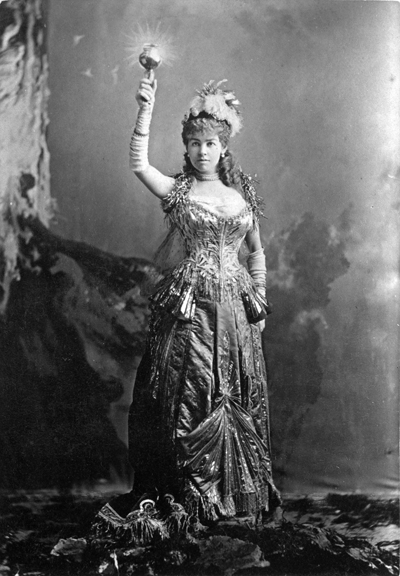Our theme for the month of March is “light.”
A woman descends the staircase, her dress aglow with electricity. Her body shimmers, ornate with light as well as jewelry. Her attire is battery-operated and utterly unforgettable. While this New Yorker seems—to our eyes—dressed for a Met Gala, those gatherings are for the future: the Metropolitan Museum of Art is only thirteen years old, and the first Met Gala is sixty-five years away. The year is 1883, and Alice Vanderbilt and her electrified dress are glittering, gorgeous beacons of the Gilded Age.
In case your US history class notes have long since been recycled: the Gilded Age stretched from about the 1870s to the 1890s, and it was a time in American history when issues of money, power, and social responsibility clashed with a furor rarely seen before. From the outside, the Gilded Age was a golden time of expansion and glittering riches; on the inside, it was a time of degradation and corruption. Almost a hundred and fifty years have passed since these years, and yet I find their questions and controversies so familiar.
Here on the post calvin, Annaka has lamented how WWII stories loom so large in the imaginations of Western storytellers. Like Annaka, I won’t exactly argue that there need to be fewer WWII (or even generally war-centric) stories told for Western (especially American) audiences. And like Annaka, I long for “more and better stories that interrogate the less examined historical conflicts, that don’t assume America to be the protagonist, and that don’t end with cute white families and proud, waving flags.” While I understood the pull toward historical settings with heightened moral and emotional stakes, we need to look beyond wartime for historical stories that pose timeless questions about humanity. Even the interim periods are not so peaceable.
So perhaps that is why, in the twenty-first century, I find myself so drawn to shows like The Gilded Age. In the 2020s, The Gilded Age is not only a bygone era but an HBO period drama whose first season features a fictionalized version of the ball where Alice Vanderbilt wore her electrified dress. The party is resplendent, of course, as are the Russells—the show’s fictionalized Vanderbilts. But they are only four of a full cast of characters inhabiting a time I find utterly fascinating.
Written by Downton Abbey scribe Julian Fellowes, the show follows Marian (blonde and rather bland, though improving in season two) as she joins her old-money aunts in high society New York, over which the Mrs. Astor presides. Across the street live the Russells, Vanderbilt doppelgangers whose railroad empire has funded a lavish home—if not social acceptance. The show also features the lives of the houses’ servants (for a little old-fashioned upstairs, downstairs drama) along with Marian’s friend Peggy Scott, a writer in the mold of Ida B. Wells. Peggy (the luminous Denée Benton, so excellent here and in Great Comet) is the story’s entry point into the Black upper class of the era. Like Downton Abbey and other ensemble period dramas, The Gilded Age boasts an enormous roster of characters (many of whom, in this case, are played by Broadway royalty like Audra McDonald and Kelli O’Hara).
Is The Gilded Age perfect? Of course not. I don’t always care about every single little plotline the show offers, and the twists and turns are often more predictable and less humanly felt than I’d like. But between the sweeping score and elaborate balls, I find the show posing questions worth pondering:
- What is the right use of money in society?
- In a society where people can change classes within a generation or even a lifetime, how do individuals and groups cling to social snobbery?
- How are charity and social climbing intertwined in society? What is the purpose of public-facing giving?
- Do and can morally corrupt patrons corrupt the arts?
- How have and do women operate with and use power (for good and ill), even when political and economic doors were closed to them?
- How does collaboration make social change happen—and what happens if those collaborators are uneasy allies?
- Where does pitying and stereotyping collide?
- Is it possible to maintain both a solid reputation and a life of integrity?
Whether you love history or find it deeply dull, I do hope you’ll find an opportunity to dwell inside a story that makes you grapple with ideas like these. Perhaps, for once, it won’t be a WWII story. And if you can make me confront these ideas and remind me of a bizarre, glittering piece of fashion history at the same time—I’ll be very eager for a third season.
To stream The Gilded Age, pay more than you’d like for an HBO Max subscription (or mooch on a friend’s account, as long as their password sharing crackdown hasn’t been implemented). To read more about the Electric Light Dress and the Vanderbilt Ball (141 years ago on March 26), check out the Museum of New York.

Courtney Zonnefeld graduated in 2018 with a degree in writing. She currently lives in Grand Rapids, Michigan, where she works for Eerdmans Books for Young Readers. In her free time, she enjoys reading, baking, and saving up for more herb plants. You can usually find her wandering a farmer’s market, hunting for vintage books, or browsing the tea selection in coffee shops.




Good questions!
Reminds me of back when I was a boy and my dad would pose questions to us after viewing pretty much anything.
Always good to reflect upon the things we see.